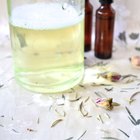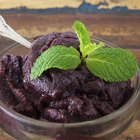Take advantage of the healing power of brilliant calendula flowers to help heal scar tissue and condition your skin. According to "The New Age Herbalist," calendula is traditional remedy for wounds, scars, stings, varicose, veins, calluses and warts. Bright orange or yellow calendula flowers are a common ingredient in skin treatments because of their wound-healing, antifungal, antibacterial and antiflammatory properties. In combination with other healing ingredients calendula ointment can effectively treat and heal scar tissue. However, you should consult with a medical professional before treating yourself with calendula products.
Calendula Officinalis
According to Barbs Backyard Blooms, Calendula officinalis, commonly called "pot marigold" is a self-seeding annual that flowers in temperate zones from June until winter frost. Harvest the bright orange or yellow flowers as they open and dry them for use in homemade skin preparations. Choose calendula skin treatments for inflamed conditions--such as sun or windburn-- and to prevent and heal scars and topical infection. Calendula flowers and essential oil are good for all skin types. They are gentle enough for damaged and sensitive skin and for use with children, says "Organic Body Care Recipes."
Commercial Calendula Ointment
There are many commercial calendula ointments available. Look for organic products that contain few chemicals and preservatives. Stephanie Tourles, licensed holistic esthetician and author of "Organic Body Care Recipes," cautions against products that contain parabens, phthalates, synthetic colors, triethanolamine, imidazolidinyl urea, DMD hydantoin and quaternium 15. These ingredients may cause complications ranging from allergies, irritation and inflammation to joint pain, cancer and reproductive abnormalities, so avoid putting them on your skin, warns Tourles.
Combinations for Healing
The effectiveness of calendula increases in combination with other healing ingredients. According to "Aromatherapy Guide to Essential Oils," galbanum essential oil has been used since ancient times to heal scars and lavender and neroli essential oils are effective as well. "The Honey Prescription" reports that raw unheated honey significantly reduces scar tissue. "Organic Body Care Recipes" says that lanolin mimics the oil in human skin; coconut oil is an effective moisturizer; and beeswax protects the skin.
Preparing Calendula Ointment
To prepare calendula ointment at home, try this simple recipe from "The Encyclopedia of Medicinal Plants." Simmer 2 cups of dried calendula flowers with 3 cups of coconut oil and 2 1/2 cups beeswax for 90 minutes over a double boiler. Mix in 10 drops of essential oil, if desired, and strain the preparation through a coffee filter or tea towel set in a wire mesh strainer. Pour it into dry sterilized glass jars and let it cool before using or storing. Your ointment will keep at room temperature.
Applying Calendula Ointment
Calendula ointment forms a protective layer on your skin and imparts the benefits of herbal healing. Apply it to wounds to prevent scarring or to existing scars to reduce scar tissue. Apply ointment to the affected areas three times a day and after bathing or swimming. Discontinue use if you experience any irritation.
Warnings
Calendula is an emmenagogue, which means it stimulates menstruation, and therefore pregnant women should avoid it, cautions "The Encyclopedia of Medicinal Plants." When preparing calendula ointment at home, sterilize containers and utensils thoroughly. Boiling is the preferred method, and you can also run them through a dishwasher or soak them for 15 minutes in a gallon of hot soapy water with 1 tsp. of bleach, recommends "Organic Body Care Recipes."
Related Articles

Burdock Root for Acne

How to Wash Your Face With Chamomile

How to Make Calendula Tea

Can I Use Henna in My Hair Every Week?

What Does Lavender Taste Like?

Homemade Shower Gel Natural Recipe

How to Make Organic Shampoo & ...

Arnica for Acne

The Use of Neem Juice in Skin Care as ...

Acai Berry & Acne

Can You Shrink Pores Using Vegetables?

Chamomile Essential Oil Benefits

Can You Freeze Spices & Herbs for ...

Fiber Sure by Metamucil Ingredients

How to Make an Oil-Free Facial Lotion

Herbs For Saunas

How to Make Organic Shoe Polish

How to Remove Yellow Stains on White ...

How to Deal With a Chapped Nose From ...

How to Make Elderberry Jam
References
- Barbs Backyard Blooms: "Calendula--Calendula officinalis"
- "The Honey Prescription"; Nathaniel Altman; 2007
- “Organic Body Care Recipes”; Stephanie Tourles; 2007
- “The New Age Herbalist”; Richard Mabey; 1988
- "The Encyclopedia of Medicinal Plants"; Andrew Chevallier; 1996
Writer Bio
Based in Bethesda, Md., Brigid Rauch has been writing about health and nutrition since 2007. Her work has appeared on websites for companies like Honest Tea. Rauch holds a master's degree in urban planning from University of Illinois at Chicago. She is a registered yoga teacher with Yoga Alliance and teaches classes in Ayurvedic holistic medicine for moms and pregnant women.